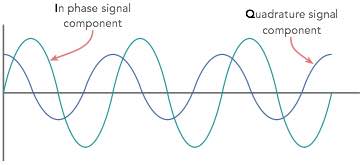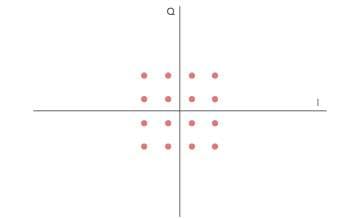What is QAM, quadrature amplitude tweak ?
 Quadrature Amplitude Modulation, QAM is a sign wherein two transporters moved in stage by 90 degrees (for example sine and cosine) are balanced and consolidated. Because of their 90° stage distinction they are in quadrature and this offers ascend to the name. Regularly one sign is known as the In-stage or "I" signal, and the other is the quadrature or "Q" signal.
Quadrature Amplitude Modulation, QAM is a sign wherein two transporters moved in stage by 90 degrees (for example sine and cosine) are balanced and consolidated. Because of their 90° stage distinction they are in quadrature and this offers ascend to the name. Regularly one sign is known as the In-stage or "I" signal, and the other is the quadrature or "Q" signal.The resultant in general sign comprising of the blend of both I and Q bearers contains of both amplitude and stage varieties. In perspective on the way that both amplitude and stage varieties are available it might likewise be considered as a blend of amplitude and stage tweak.
An inspiration for the utilization of quadrature amplitude regulation originates from the way that a straight amplitude balanced sign, for example twofold sideband even with a stifled bearer involves double the data transfer capacity of the regulating signal. This is exceptionally inefficient of the accessible recurrence range. QAM reestablishes the parity by setting two free twofold sideband smothered bearer flag in a similar range as one common twofold sideband supressed transporter signal.
Simple and advanced QAM
Quadrature amplitude balance, QAM may exist in what might be named either simple or advanced configurations. The simple renditions of QAM are normally used to enable different simple sign to be carried on a solitary transporter. For instance it is utilized in PAL and NTSC TV frameworks, where the various channels gave by QAM empower it to convey the parts of chroma or shading data. In radio applications a framework known as C-QUAM is utilized for AM stereo radio. Here the various channels empower the two channels required for sound system to be carried on the single transporter.Computerized organizations of QAM are frequently alluded to as "Quantised QAM" and they are in effect progressively utilized for information correspondences regularly inside radio interchanges frameworks. Radio correspondences frameworks extending from cell innovation as on account of LTE through remote frameworks including WiMAX, and Wi-Fi 802.11 utilize an assortment of types of QAM, and the utilization of QAM will just increment inside the field of radio interchanges.
Advanced/Quantised QAM nuts and bolts
Quadrature amplitude balance, QAM, when utilized for computerized transmission for radio interchanges applications can convey higher information rates than standard amplitude tweaked plans and stage adjusted plans.
Fundamental sign show just two positions which permit the exchange of either a 0 or 1. Utilizing QAM there are a wide range of focuses that can be utilized, each having characterized estimations of stage and amplitude. This is known as a group of stars graph. The various positions are relegated various qualities, and along these lines a solitary sign can move information at an a lot higher rate.

Bit arrangement mapping for a 16QAM sign
Group of stars graph for a 16QAM sign indicating the area of the various focuses
As appeared over, the group of stars focuses are normally organized in a square lattice with equivalent flat and vertical dispersing. In spite of the fact that information is double the most widely recognized types of QAM, despite the fact that not all, are the place there heavenly body can shape a square with the quantity of focuses equivalent to an intensity of 2 for example 4, 16, 64 . . . . , for example 16QAM, 64QAM, and so forth.
By utilizing higher request tweak positions, for example more focuses on the heavenly body, it is conceivable to transmit more bits per image. Anyway the focuses are nearer together and they are in this manner progressively vulnerable to commotion and information mistakes.
The benefit of moving to the higher request positions is that there are more focuses inside the star grouping and in this manner it is conceivable to transmit more bits per image. The drawback is that the star grouping focuses are nearer together and in this way the connection is increasingly helpless to clamor. Subsequently, higher request adaptations of QAM are possibly utilized when there is an adequately high sign to commotion proportion.
To give a case of how QAM works, the star grouping graph beneath shows the qualities related with the various states for a 16QAM sign. From this it tends to be seen that a persistent piece stream might be assembled into fours and spoke to as a succession.
Bit succession mapping for a 16QAM sign
Bit succession mapping for a 16QAM sign
Ordinarily the most reduced request QAM experienced is 16QAM. The explanation behind this being the most reduced request ordinarily experienced is that 2QAM is equivalent to paired stage move keying, BPSK, and 4QAM is equivalent to quadrature stage move keying, QPSK.
Moreover 8QAM isn't broadly utilized. This is on the grounds that blunder rate execution of 8QAM is nearly equivalent to that of 16QAM - it is just about 0.5 dB better and the information rate is just seventy five percent that of 16QAM. This emerges from the rectangular, instead of square state of the star grouping.
QAM points of interest and drawbacks
In spite of the fact that QAM seems to build the productivity of transmission for radio correspondences frameworks by using both amplitude and stage varieties, it has various disadvantages. The first is that it is increasingly defenseless to commotion on the grounds that the states are nearer together with the goal that a lower level of clamor is expected to move the sign to an alternate choice point. Recipients for use with stage or recurrence tweak are both ready to utilize constraining speakers that can evacuate any amplitude commotion and along these lines improve the clamor dependence. This isn't the situation with QAM.
The subsequent impediment is additionally connected with the amplitude part of the sign. At the point when a stage or recurrence balanced sign is enhanced in a radio transmitter, there is no compelling reason to utilize straight speakers, though when utilizing QAM that contains an amplitude segment, linearity must be kept up. Shockingly direct speakers are less proficient and expend more power, and this makes them less appealing for portable applications.




0 Comments